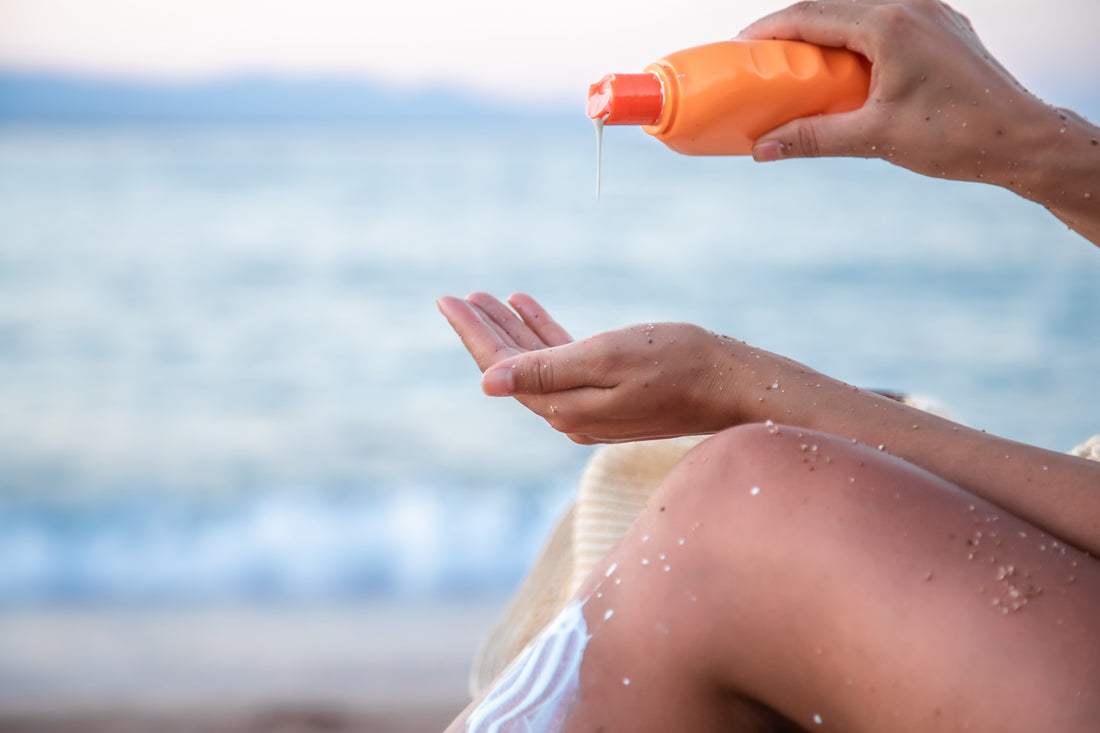We have all been told that we need to protect ourselves from the sun and slather on loads of sunscreen so we don’t get skin cancer. But did you know that most conventional sunscreens are filled with chemicals that cause cancer?
In this post we will cover the benefits of the sun (vitamin D), chemical vs mineral sunscreens, chemicals to look out for, and brands you can swap to.
It's important to note that chemical sunscreens work by absorbing UV rays, while mineral sunscreens, containing ingredients like zinc oxide or titanium dioxide, work by reflecting and scattering UV rays away from the skin's surface.
Chemical Sunscreens: The Dark Side of Sunshine
These are the active ingredients you want to steer clear of.
- Avobenzone
- Benzophenone
- Homosalate
- Octinoxate/Ethylhexyl Methoxycinnamate
- Oxybenzone
- Octisalate
- Benzene
Issues with these active ingredients:
- Mimics hormones in the body, interfering with the endocrine system's proper functioning
- Easily absorbed by the skin, has been detected in breast milk, blood, and urine samples
- Lowers testosterone and lowers sperm count
- Allergies and skin irritation
- Messes with thyroid and hormones
- Kills Coral reefs (they are necessary for our ecosystem)
- They are ban in other countries
These are the inactive ingredients you want to avoid:
- Parabens
- Fragrance
- BHT (Butylated Hydroxytoluene)
- Ethoxylated Ingredients
- Phenoxyethanol
- PEGs
Chemical Sunscreens Brands to Avoid:
- Australian Gold
- Aveeno
- Babyganics
- Banana Boat
- CeraVe
- Coola
- Coppertone
- CVS
- EltaMD
- Equate
- Hawaiian Tropic
- Neutrogena
- Nivea
- Sun Bum
- Super Goop (Unseen, Play Everyday)
- Target Generic Brand
One notable recall in recent years was in 2020 when Johnson & Johnson announced a voluntary recall of specific lots of its Neutrogena and Aveeno sunscreens due to the detection of benzene, a known carcinogen. Banana Boat was also a brand that has high levels of benzene tested in their products.
Aerosol Alarms: Spray with Caution
Aerosol sunscreens release tiny particles into the air that can be inhaled during application. These particles can be potentially harmful if they reach the lungs, especially in individuals with respiratory issues like asthma or allergies.
Some aerosol sunscreens contain nanoparticles of active sunscreen ingredients like titanium dioxide or zinc oxide. These nanoparticles, if inhaled, could potentially penetrate lung tissue, causing damage or leading to health concerns.
Aerosol sunscreens use propellants to disperse the product. These propellants, if inhaled, might irritate the respiratory system. Due to this, I avoid Aerosol sunscreens at all costs.
Mineral Sunscreens
These are the ones you want to use, but hold on, there are some caveats.
In 2021, the FDA, found only two ingredients, zinc oxide and titanium dioxide are the only safe ingredients to use, these are the ingredients in Mineral Sunscreens.
However, the concern within the sunscreen industry extends beyond oxybenzone. Nanotechnology, often veiled within seemingly "natural" brands, introduces another dilemma. Some brands opt for nano titanium dioxide and nano zinc oxide instead of their regular counterparts.
These minute particles serve a purpose in sunscreen, aiming to diminish the visible whiteness upon application. But here's the catch: Nano titanium dioxide has been associated with speeding up the skin aging process. When exposed to UV radiation, nanoparticles tend to heat up, inducing oxidative stress that expedites aging and wrinkles. To counteract this, manufacturers have coated titanium dioxide nanoparticles with silicone and aluminum.
Mineral Sunscreens we love that are Non-Nano:
- Kinfield (springforward15 for 15% off)
- Babo Botanicals
- Think Body
- Earth Mama
- Pipette
- Badger
- Attitude
- SuperGoop (only the Mineral Sheer Screen)
- Beauty by Earth
- All Good
- Derma-E
- Mad Hippie

UV & Vitamin D: The Sunscreen Conundrum
The sun provides a vital source of Vitamin D, a nutrient crucial for various bodily functions. When the skin is exposed to sunlight, specifically UVB rays, a chemical reaction occurs, triggering the synthesis of Vitamin D in the skin. This natural process is essential as Vitamin D helps regulate calcium and phosphorus absorption, contributing to bone health and aiding immune system function. It also plays a role in supporting cardiovascular health, cognitive function, and mood regulation. Adequate exposure to sunlight helps the body produce Vitamin D, ensuring proper physiological functions and overall well-being. However, it's essential to balance sun exposure to prevent overexposure and the associated risks of sunburn and skin damage. I like to do 15-20 mins in direct sunlight without any sunscreen.
Sunglasses and Circadian Rhythm
Sunlight plays a crucial role in regulating our body's circadian rhythm, which governs our sleep-wake cycle and numerous bodily functions. This is why getting morning sunlight is so important. Exposure to natural light, especially during the day, helps synchronize our internal body clock, signaling when it's time to be awake and active. This exposure to daylight suppresses the production of melatonin, a hormone that induces sleep, thereby keeping us alert and active during the day.
Eyes are instrumental in this process as they have photoreceptors that detect light and transmit this information to the brain. However, wearing sunglasses that effectively block sunlight, particularly during the day, can potentially interfere with this natural cycle. I try to avoid wearing sunglasses for the sake of wearing sunglasses unless it is totally necessary, or if needed for fashion.


